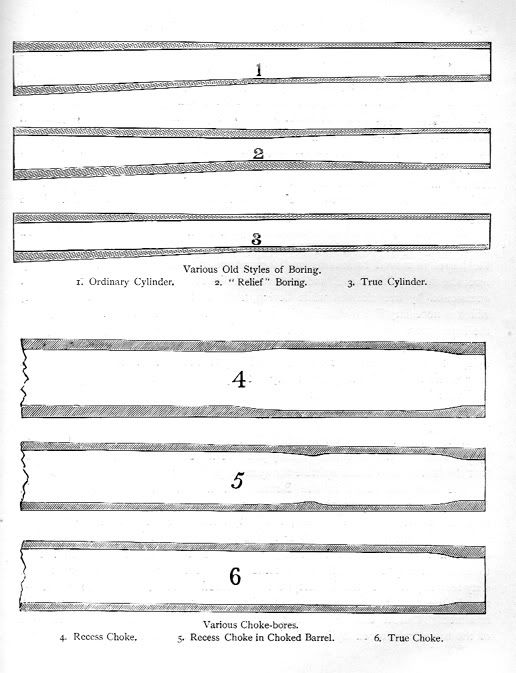roundball said:
I read some posts or an article somewhere that claimed with all else equal, a longer smoothbore barrel would give a tighter shot pattern.
ie: 32" vs. 38" cylinder bore...the 38" would produce a tighter shot pattern.
Anybody have any actual hands on experience or official reference documentation to know if thats an across-the-board fact and not just an old wives tale?
There are many factors to consider.
One cannot say that a long barrel patterns better without considering the BORING of the barrel.
In my limited experience I can say that the boring of modern ML shotgun barrels leaves a lot to be desired. Most are rougher than they should be. BUT.
A rough breech end of the barrel was thought to work better, giving better velocity than a very smooth barrel would.
Below is a page from W.W. Greeners "The Gun and its Developement" 1896.
1, 2, 3 are ML boring styles.
Many thought that #2 was best for ML guns.
W. Greeners "The Gun" circa 1835 is available on google books as a download. While like all 19th century books it has some pretty strange ideas on internal ballistics it has a lot of information that is of interest.
Bottom line? The long barreled fowler died off pretty rapidly after 1780s-90s in England. They were the leaders in shotgun development.
I think the short barrels came about for several reasons. The most important was wing shooting. This sport requires a faster handling gun than can be obtained with a 42-48" barreled gun.
It was also impossible to make a usable double barrel with long barrels.
George in "British Guns and Rifles" attributes the shorter barrels to improved powders and breech designs that produced better velocity so a long barrel was not needed to produce the desired range and penetration.
But overall I think wing shooting was the real mover in shortening barrels. The better powder and breeches like the Nock made it possible with not loss of performance and in fact may have made the shorter guns of the later era more effective than the long barreled guns.
HOWEVER, most Americans did not own and could not afford a double barreled fowling piece made by Mortimer or Twigg etc and the American fowler barrel did not shorten as quickly. But wing shooting is not the sport of the subsistence or market hunter. For shooting turkeys, ducks on the water or quail in the covey there is no disadvantage to the long barrel.
Dan






